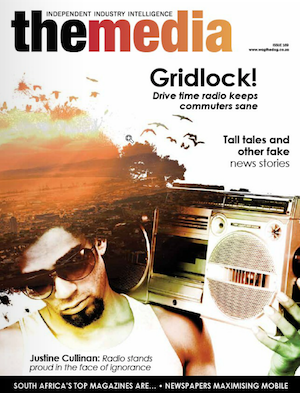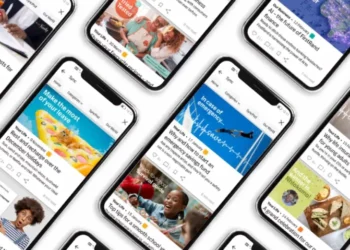The latest BRC Radio Audience Measurement (RAM) numbers, which were for the first full year of research, continue to reflect longer listening times and a listening curve that no longer has sharp peaks that stand out during the drive time periods. But this does not mean that drive time radio is any less important. MICHAEL BRATT turns the dial.
While peaks still remain at drive time periods for most radio stations, the listening curve has begun to flatten out, particularly when afternoon drive time is compared to the rest of the day. Independent media consultant, Britta Reid, gives her take on this trend. “The overall weekday radio listenership curve shown by the BRC RAM data (June – Dec 2016) affirms the importance of traditional morning drive time, with listening peaking at 07h00. With the new data showing us longer and loyal listeners, there is a less pronounced difference between listenership through the rest of the day and the traditional afternoon drive time figures,” she says.
This could also be attributed to the fact that the BRC RAM research includes both cross-device and cross-location listening rather than only traditional radio.
“The BRC RAM data has revealed that approximately a third of radio listening takes place in vehicles,” says Reid. “Of course, this in-vehicle listenership varies significantly by radio station, and is linked to factors such as living in metropolitan areas and employment. For some stations in-vehicle listenership is particularly high: 69% in the case of 947, 59% in the case of Classic FM and 5FM, 58% in the case of Jacaranda FM and 57% in the case of 702.”
Reid adds, “Statistics such as these raise the question of whether we need to reconsider our notions of drive time, because we will be realistically reaching a significant proportion of these listenerships in their cars throughout the weekday, and, indeed, over weekends. Arguably, we should begin to consider broadcast time in terms of consumer mindset and requirements. What we have defined as morning drive time is more about starting the day: Waking up, getting out of bed, getting breakfast and getting toward, while afternoon derivative is about navigating the traffic, planning the evening and beginning to unwind.”
Drive time at a local level
It’s not just the big radio stations that are continuing to find value and look after their drive time listeners. Community radio stations are also continuing to focus on these periods.
Nkopane Maphiri, CEO of The Media Connection, says there’s “no doubt that radio audience daily consumption patterns haven’t changed much over the years, as we’ve seen in the latest BRC RAMS figures. Drive time is still a major audience contributor to any radio station’s daily listening profile.
 “Community radio,” he adds, “has remarkably shown its resilience and strength over the years. Its ability to deliver audiences has by far surpassed expectations. The steady audience growth year-on-year is an indication of the demand by listeners for more relevant and locally focused programming which community radio has and continues to deliver.”
“Community radio,” he adds, “has remarkably shown its resilience and strength over the years. Its ability to deliver audiences has by far surpassed expectations. The steady audience growth year-on-year is an indication of the demand by listeners for more relevant and locally focused programming which community radio has and continues to deliver.”
Maphiri says locally flavoured and nuanced drive time programming on community radio has been championing this audience growth. “The endless talent pool that comes from community radio is playing a major part in shaping the content relevance at stations, credit to the close proximity of the DJs and in particular drive time DJs to their listeners on a daily basis,” he says.
Primedia Broadcasting COO, Ryan Till, echoes Maphiri’s sentiments. “One of the major strengths of radio is the intimacy – having the on-air team in your car, which makes listeners feel like they are part of the show,” he says. “We maximise that effect of feeling part of the show through highly interactive drive time formats, and heavyweight presenters who are respected, looked up to and exciting – personalities who our listeners would love to meet and talk to.”
Stations taking heed of BRC RAM data
Radio stations are taking notice of the BRC RAM data and making moves to continue to enhance not just drive time radio, but radio listening as a whole. Primedia Broadcasting, the group behind 947, 702, KFM and CapeTalk, made two major moves in drive time radio recently. John Robbie’s departure from 702’s Breakfast Show was met with much shock and dismay, but the show’s new host, Xolani Gwala, has been doing a sterling job in keeping this show entertaining and engaging.
702 station manager, Thabisile Mbete, shares her thoughts. “Drive time radio still commands respect from audiences and newsmakers and our drive time shows are fortunate to secure many of the big newsmakers from that day for interviews. This is turn, pulls in listeners who want to hear the news from the source.”
 Till, adds, “Traffic is consistently bad in our cities and time spent in cars is steady or growing for many as our cities expand. Despite the growth of digital audio options, radio listening is still very strong in South Africa, and we have a captive audience, desperately seeking compelling content to both distract them from the gridlock, and inform them to help them manage their way through it”.
Till, adds, “Traffic is consistently bad in our cities and time spent in cars is steady or growing for many as our cities expand. Despite the growth of digital audio options, radio listening is still very strong in South Africa, and we have a captive audience, desperately seeking compelling content to both distract them from the gridlock, and inform them to help them manage their way through it”.
The other major drive time shakeup at Primedia Broadcasting was swapping around its Breakfast Xpress and Afternoon Drive presenter teams. Of this swap, 947 station manager Ravi Naidoo says, “The drive time switch on 947 aims to feed into the natural rhythm of the city – Anele and her high energy team to kick off the day, and then easy going, fun banter with the Afternoon Xpress to wind things down”.
For advertisers, “Drive time shows still deliver the biggest response – they are very powerful and we’re taking advantage of this by tailor making converged solutions to the different day parts… The connectivity and engagement levels of the drive time shows are the highest and our audiences are very responsive through SMS, WhatsApp, voice notes, calls and social media – with impressive results for client campaigns”, says Naidoo.
The appeal of drive time radio
Katy Katopodis, EWN editor in chief, says audience engagement is also crucial for drive time radio. “Our traffic bulletins draw heavily on crowd-sourced information and we like to acknowledge the listeners who submit information in the bulletins – to recognise their contribution to thousands of other motorists, which results in repeat submissions from these citizen journalists who feel part of the station and the traffic community. The news bulletins during drive time radio shows are appointment listening – more so than ever in our current news environment where things are changing so fast and audiences need to look to credible sources for information they can trust.”
Similarly with the afternoon drive time, listeners are winding down and want to be entertained and accompanied by great content, which seems to be a cornerstone of drive time radio. Taryn Hood, media strategy manager at Primedia Broadcasting, says all the company’s stations deliver exceptionally high in-car listening, according to BRC RAM data from March 2017, “which shows that they are engaged, mobile and open to impulse purchasing. This also points to factors such as employment and disposable income, which reinforces the figures that show that our audiences reflect the highest average household income in Gauteng and the Western Cape”.
Hood cites a study conducted for the RAB UK, Media and Mood of the Nation, Sparkler RAB UK, 2011, which proved that radio has a positive mood enhancing effect. “It’s no wonder people want to tune into radio, as a mood enhancing ‘pick-me-up’ en route to and from work, fighting the traffic and diffusing aggravating stress,” Hood says.
Denver Apollus, head of programming at Heart FM, says radio still has relevance but that listeners consume radio differently these days. “They are hungry for content and information to assist in their daily routines. Traffic, news, weather and sport remain constant and this needs to be dressed with compelling content from the presenters. With regards to the Western Cape – traffic volumes are steadily increasing and therefore the demand for drive time radio ‘services’ is greater.”
 Heart FM’s drive time strategy is centred on compelling content. “We are extremely driven to deliver content that resonates with our audience and we pride ourselves in contextualising this for our listeners. We engage in a unique manner and we have the ability to ask the really tough questions and to also find humour in the weirdest and wildest uniquely Cape Town ‘things’. With a cast largely born and bred in the Mother City they bring the nostalgia and the loyalty to life as they involve our listener in the conversations. We do not to talk to our listeners we engage them.”
Heart FM’s drive time strategy is centred on compelling content. “We are extremely driven to deliver content that resonates with our audience and we pride ourselves in contextualising this for our listeners. We engage in a unique manner and we have the ability to ask the really tough questions and to also find humour in the weirdest and wildest uniquely Cape Town ‘things’. With a cast largely born and bred in the Mother City they bring the nostalgia and the loyalty to life as they involve our listener in the conversations. We do not to talk to our listeners we engage them.”
While BRC RAM data points to longer radio listening and listening throughout the day on a multitude of devices, and in a multitude of places, it is clear that drive time radio remains as important as ever before. The place it holds in people’s daily routines is arguably what makes it so engaging with listeners, who look for compelling content, entertainment and engagement. So while you may be stuck in a queue of cars that doesn’t seem to be going anywhere, you will always have a friendly travel companion, in the presenters behind drive time radio.
This story was published in the April 2017 issue of The Media. To read the magazine, click on the cover.















